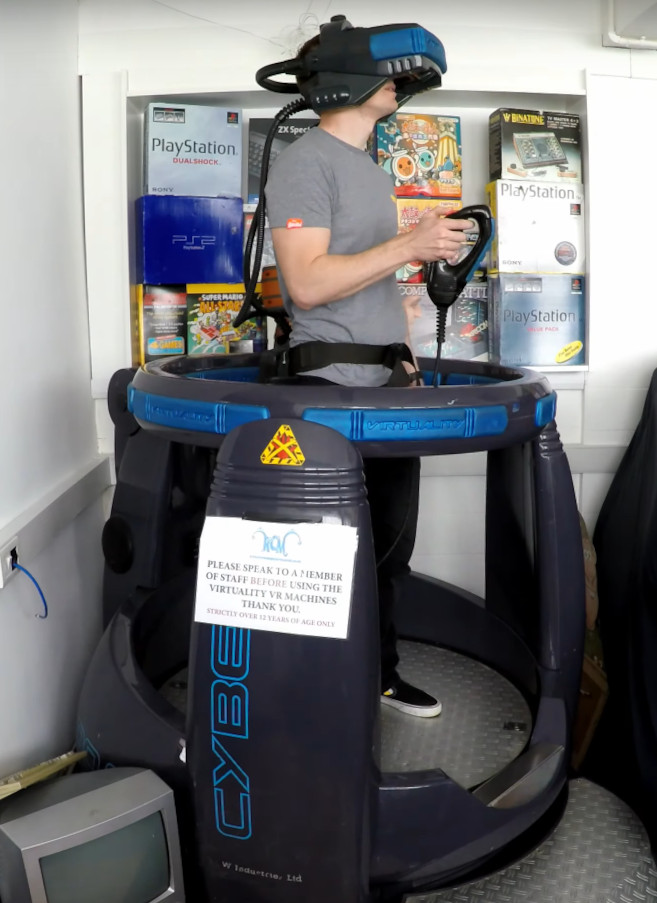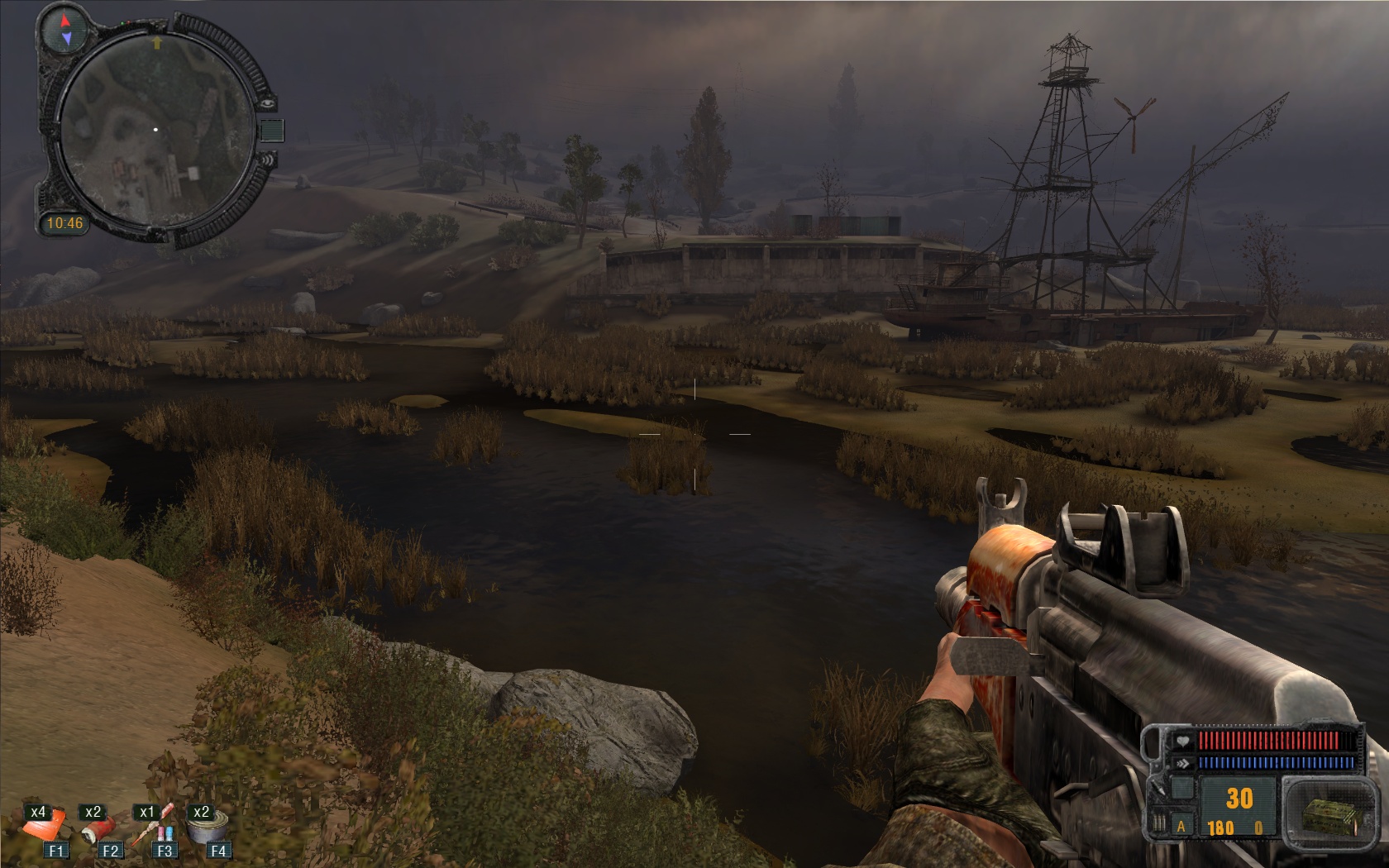|
Virtuality Entertainment
Virtuality was a range of virtual reality machines produced by Virtuality Group, and found in video arcades in the early 1990s. The machines delivered real-time VR gaming via a stereoscopic Virtual reality headset, VR headset, joysticks, tracking devices and networked units for a multi-player gaming, multi-player experience. Virtuality Group was originally founded in October 1987 as "W Industries", named after Dr. Jonathan D Waldern, and renamed to Virtuality in 1993. Work by Waldern at the Human Computer Interface Research Unit of De Montfort University, Leicester Polytechnic (now De Montfort University), which later moved to Loughborough University, had by 1986 produced a system known as the "Roaming Caterpillar" that could deliver a stereoscopic view of a three-dimensional scene. The image was viewed on a moveable Cathode-ray tube, CRT screen using Active shutter 3D system, shutter glasses, with head and hand tracking incorporating acoustic sensors to determine the user's positio ... [...More Info...] [...Related Items...] OR: [Wikipedia] [Google] [Baidu] |
Olin Corporation
Olin Corporation is an American manufacturer of ammunition, chlorine, and sodium hydroxide. The company traces its roots to two companies, both founded in 1892: Franklin W. Olin's Equitable Powder Company and the Mathieson Alkali Works. Accidents at Olin chemical plants have exposed employees and nearby residents to health hazards. History Founding and expansion (1890s-1900s) The company was started by Franklin Walter Olin in Niagara Falls, New York as the Equitable Powder Company. Olin created the company for the purpose of supplying the area's coal mines and limestone quarries with explosives. Olin's blasting and gunpowder company expanded into the production of cartridges in 1898. The company bought a paper manufacturer (the Ecusta Paper Company in Pisgah Forest, North Carolina),''Ecusta'' [...More Info...] [...Related Items...] OR: [Wikipedia] [Google] [Baidu] |
Deathmatch (video Games)
Deathmatch, also known as free-for-all, is a gameplay mode integrated into many shooter games, including FPS game, first-person shooter (FPS), and real-time strategy (RTS) video games, where the goal is to kill (or Glossary of video game terms#frag, "frag") the other players' characters as many times as possible. The deathmatch may end on a ''frag limit'' or a ''time limit'', and the winner is the player that accumulated the greatest number of frags. The deathmatch is an evolution of competitive Multiplayer video game, multiplayer modes found in game genres such as fighting games and racing video game, racing games moving into other genres. Gameplay In a typical first-person shooter (FPS) deathmatch session, players connect individual computers together via a computer network in a peer-to-peer model or a client–server model, either locally or over the Internet. Players often have the option to communicate with each other during the game by using microphones and speakers. De ... [...More Info...] [...Related Items...] OR: [Wikipedia] [Google] [Baidu] |
First-person Shooter
A first-person shooter (FPS) is a video game genre, video game centered on gun fighting and other weapon-based combat seen from a First person (video games), first-person perspective, with the player experiencing the action directly through the eyes of the player character, main character. This genre shares multiple common traits with other shooter video games, shooter games, and in turn falls under the action games category. Since the genre's inception, advanced 3D computer graphics, 3D and 2.5D, pseudo-3D graphics have proven fundamental to allow a reasonable level of immersion in the three-dimensional space, game world, and this type of game helped pushing technology progressively further, challenging hardware developers worldwide to introduce numerous innovations in the field of graphics processing units. Multiplayer video game, Multiplayer gaming has been an integral part of the experience, and became even more prominent with the diffusion of internet connectivity in recen ... [...More Info...] [...Related Items...] OR: [Wikipedia] [Google] [Baidu] |
Virtuality VR Dactyl Nightmare Arcade Game
Virtual reality (VR) is a simulated experience that employs 3D near-eye displays and pose tracking to give the user an immersive feel of a virtual world. Applications of virtual reality include entertainment (particularly video games), education (such as medical, safety, or military training) and business (such as virtual meetings). VR is one of the key technologies in the reality-virtuality continuum. As such, it is different from other digital visualization solutions, such as augmented virtuality and augmented reality. Currently, standard virtual reality systems use either virtual reality headsets or multi-projected environments to generate some realistic images, sounds, and other sensations that simulate a user's physical presence in a virtual environment. A person using virtual reality equipment is able to look around the artificial world, move around in it, and interact with virtual features or items. The effect is commonly created by VR headsets consisting of a head-mo ... [...More Info...] [...Related Items...] OR: [Wikipedia] [Google] [Baidu] |
Six Degrees Of Freedom
Six degrees of freedom (6DOF), or sometimes six degrees of movement, refers to the six mechanical degrees of freedom of movement of a rigid body in three-dimensional space. Specifically, the body is free to change position as forward/backward (surge), up/down (heave), left/right (sway) translation in three perpendicular axes, combined with changes in orientation through rotation about three perpendicular axes, often termed yaw (normal axis), pitch (transverse axis), and roll (longitudinal axis). Three degrees of freedom (3DOF), a term often used in the context of virtual reality, typically refers to tracking of rotational motion only: pitch, yaw, and roll. Robotics Serial and parallel manipulator systems are generally designed to position an end-effector with six degrees of freedom, consisting of three in translation and three in orientation. This provides a direct relationship between actuator positions and the configuration of the manipulator defined by its forwa ... [...More Info...] [...Related Items...] OR: [Wikipedia] [Google] [Baidu] |
TMS34020
The TMS34010, developed by Texas Instruments and released in 1986, was the first programmable graphics processor integrated circuit. While specialized graphics hardware existed earlier, such as blitters, the TMS34010 chip is a microprocessor which includes graphics-oriented instructions, making it a combination of a CPU and what would later be called a GPU. The chip was heavily used in arcade video games from the late 1980s through the mid 1990s, primarily from Atari Games and Midway Games. It was first used in '' NARC'' in 1988, then other games including ''Hard Drivin''', ''Smash TV'', ''Mortal Kombat'', and ''NBA Jam''. It was also part of computer workstation video accelerator boards in the 1990s. TI later released the TMS34020 with an emphasis on 3D rendering. History The design of the TMS34010 was led by Karl Guttag, who previously worked on the TMS9918 video display controller first used in the TI-99/4A. Development took place at TI facilities in Bedford (UK) and Houst ... [...More Info...] [...Related Items...] OR: [Wikipedia] [Google] [Baidu] |
Amiga Chip RAM
Chip RAM is a commonly used term for the integrated RAM used in Commodore's line of Amiga computers. Chip RAM is shared between the central processing unit (CPU) and the Amiga's dedicated chipset (hence the name). It was also, rather misleadingly, known as "graphics RAM". Direct memory access Under the Amiga architecture, the direct memory access (DMA) controller is integrated into the Agnus (Alice on AGA models) chip. Both the CPU and other members of the chipset have to arbitrate for access to shared RAM via Agnus. This allows the custom chips to perform video, audio, or other DMA operations independently of the CPU. As the 68000 processor used in early Amiga systems usually only accesses memory on every second memory cycle, Agnus operates a system where the "odd" clock cycle is allocated to time-critical custom chip access and the "even" cycle is allocated to the CPU: thus, for average DMA demand, the CPU is not typically blocked from memory access and may run without inter ... [...More Info...] [...Related Items...] OR: [Wikipedia] [Google] [Baidu] |
Amiga 3000
The Amiga 3000, or A3000, is a personal computer released by Commodore in June 1990. It is the successor to the Amiga 2000 and its upgraded model Amiga 2500 with more processing speed, improved graphics, and a new revision of the operating system. Its predecessors, the Amiga 500, 1000 and 2000, share the same fundamental system architecture and consequently perform without much variation in processing speed despite considerable variation in purchase price. The A3000 however, was entirely reworked and rethought as a high-end workstation. The new Motorola 32-bit 68030 CPU, 68882 math co-processor, and 32-bit system memory increase the integer processing speed by a factor of 5 to 18, and the floating-point processing speed by a factor of 7 to 200 times. The new 32-bit Zorro III expansion slots provide for faster and more powerful expansion capabilities. In common with earlier Amigas the 3000 runs a 32-bit operating system called AmigaOS. Version 2.0 is generally considered t ... [...More Info...] [...Related Items...] OR: [Wikipedia] [Google] [Baidu] |
Imagine Media
Future US, Inc. (formerly known as Imagine Media and The Future Network USA) is an American media corporation specializing in targeted magazines and websites in the video games, music, and technology markets. Headquartered in New York City, the corporation has offices in: Alexandria, Virginia; Minneapolis, Minnesota; and Washington, D.C. Future US is owned by parent company, Future plc, a specialist media company based in Bath, Somerset, England. History The company was established when Future plc acquired struggling Greensboro ( N.C.) video game magazine publisher GP Publications, publisher of '' Game Players'' magazine, in 1994. The company launched a number of titles including ''PC Gamer'', and relocated from North Carolina to the San Francisco Bay Area, occupying various properties in Burlingame and South San Francisco. When Chris Anderson, the founder of Future plc, sold Future to Pearson plc he retained GP, renamed Imagine Media, Inc. in June 1995, and operated ... [...More Info...] [...Related Items...] OR: [Wikipedia] [Google] [Baidu] |
Next Generation (magazine)
''Next Generation'' was a US video game magazine that was published by Imagine Media (now Future US). It was affiliated to and shared content with the UK's '' Edge'' magazine. ''Next Generation'' ran from January 1995 until January 2002. It was published by Jonathan Simpson-Bint and edited by Neil West. Other editors included Chris Charla, Tom Russo, and Blake Fischer. ''Next Generation'' initially covered the 32-bit consoles including 3DO, Atari Jaguar, and the then-still unreleased Sony PlayStation and Sega Saturn. Unlike competitors '' GamePro'' and '' Electronic Gaming Monthly'', the magazine was directed towards a different readership by focusing on the industry itself rather than individual games. Publication history The magazine was first published by GP Publications up until May 1995 when the publisher rebranded as Imagine Media. In September 1999, ''Next Generation'' was redesigned, and its cover name shortened ''NextGen''. A year later, in September 2000, the ma ... [...More Info...] [...Related Items...] OR: [Wikipedia] [Google] [Baidu] |
London International Financial Futures And Options Exchange
The London International Financial Futures and Options Exchange (LIFFE, pronounced 'life') was a futures exchange based in London. In 2014, following a series of takeovers, LIFFE became part of Intercontinental Exchange, and was renamed ICE Futures Europe. Euronext acquired LIFFE in 2002, and were then in turn taken over by NYSE in 2007, to form NYSE Euronext. In the same manner, Intercontinental Exchange then purchased NYSE Euronext in 2013. History The London International Financial Futures Exchange (LIFFE), established by Sir Brian Williamson started life on 30 September 1982, to take advantage of the removal of currency controls in the UK in 1979. The exchange modelled itself after the Chicago Board of Trade and the Chicago Mercantile Exchange. It initially offered futures contracts and options linked to short-term interest rates. In 1993 LIFFE merged with the ''London Traded Options Market'' (LTOM), adding equity options to its product range. This is when it ch ... [...More Info...] [...Related Items...] OR: [Wikipedia] [Google] [Baidu] |




